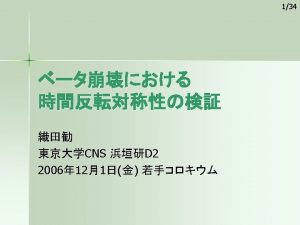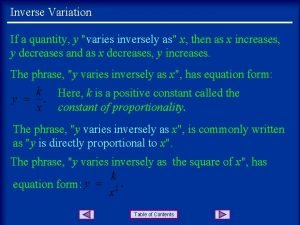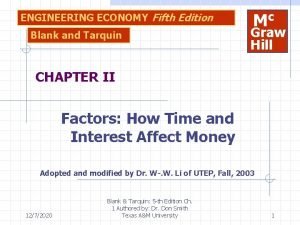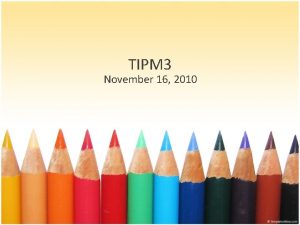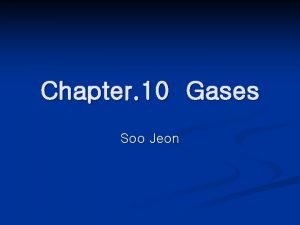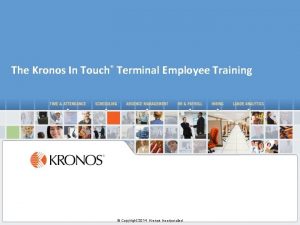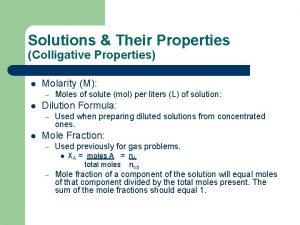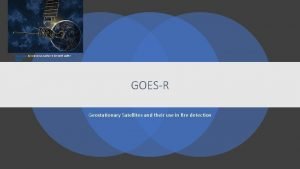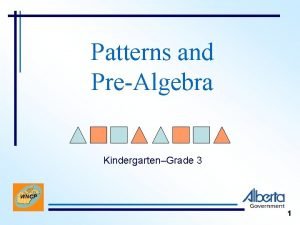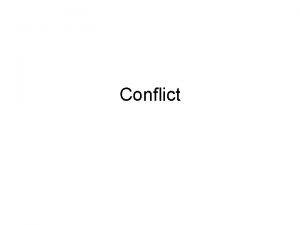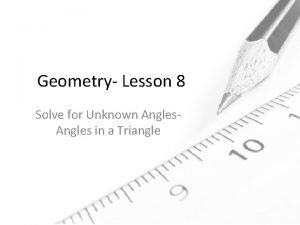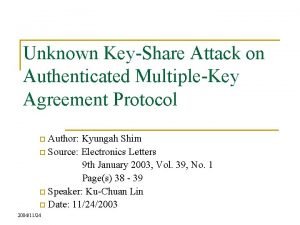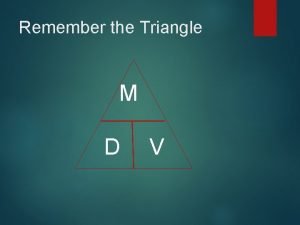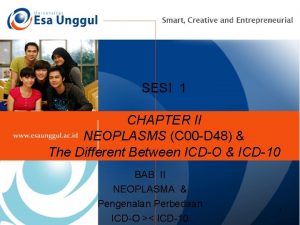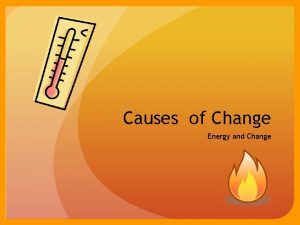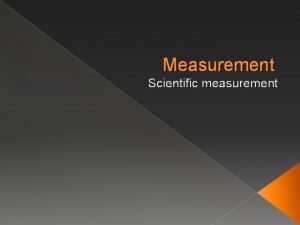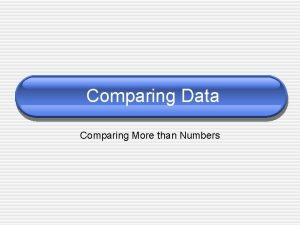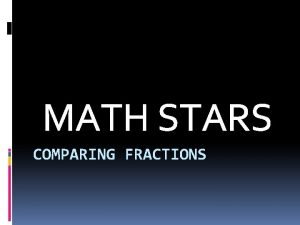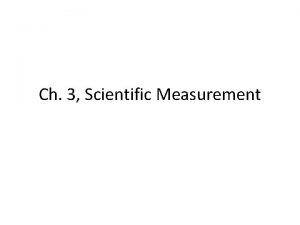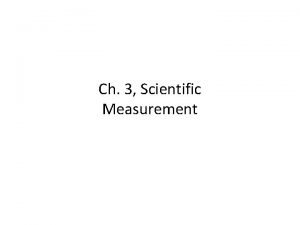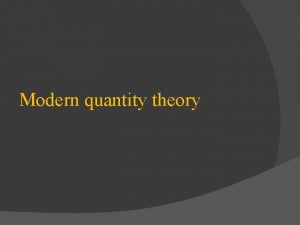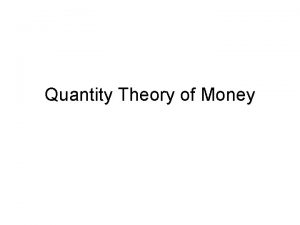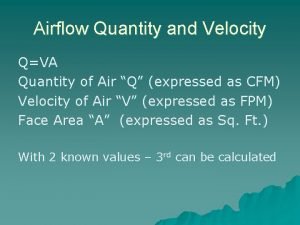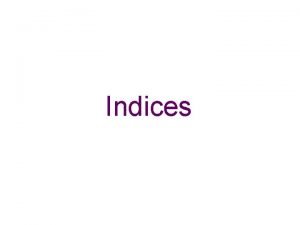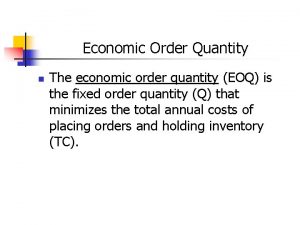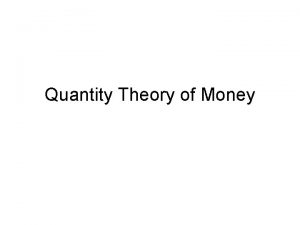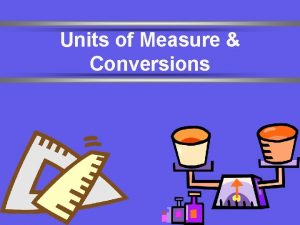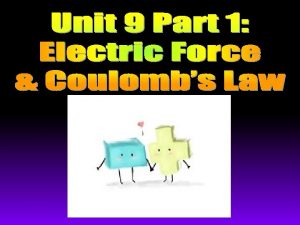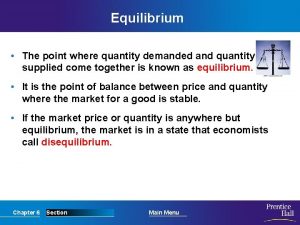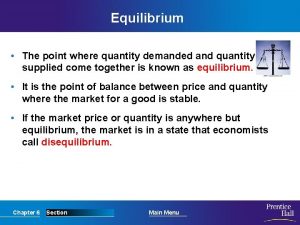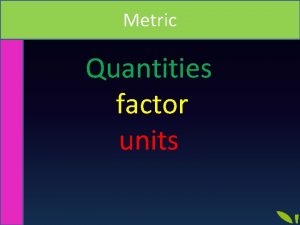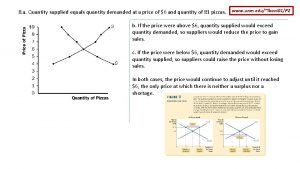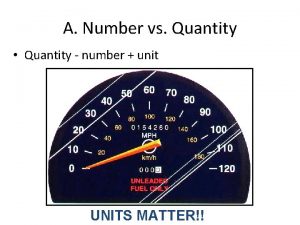Measurement Measurement Measurement is comparing an unknown quantity



























- Slides: 27

Measurement • Measurement: Measurement is comparing an unknown quantity with a known, fixed quantity of the same kind. • Non-Standard units: Non-Standard units of measurement are units that give different measure when used by anyone. e. g. Hand Span, Cubit, Foot and Yard. Hand Span The distance between the tip of the thumb and the little finger of an outstretched palm Cubit The distance between the tip of the middle finger and the elbow Foot The distance between the big toe and the heel of the foot

Standard units • Standard units: Standard units of measurement are units that give same measure when used by anyone. e. g. CGS, MKS or SI and FPS units of measurement. CGS MKS Length Centimeter Meter FPS Foot Units of Length 1 cm 10 mm 1 g 1000 mg 1 kg 1000 g 1 t 1000 kg Mass Gram Kilogram Pound 1 m Time Second 1 km 1000 m Secon d Units of Mass 100 cm

Units of Time 1 min 60 sec 1 week 7 days 1 h 60 min 1 year 365 days 1 day 24 h 1 decade 10 years

Questions? • • What instruments are used to take measurements? What do you mean by Measurements? Define the terms (i) Hand span (ii) Cubit (iii) Foot What is the disadvantage of non-standard units? What is Standard units of Measurements? What do you mean by SI System of Measurements? What are the SI Unit of Mass, Length, Time and Temperature?

Questions • • What is the full form of MKS System? What is the full form of CGS System? What is the fill form of FPS System? What is Estimation? What is Accuracy? What do you mean by Length?

Questions and Answers • • In what unit do we measure Rice? In what unit do we measure Mustard Oil? What is the need of Measurement? If we use Hand Span as a standard unit of measurement what difficulties would we experience? • Why should we use standard units of measurement? • What are the possible errors that one might make while measuring the length of a metal bar with the help of a metre rod?

Questions • • • State the CGS unit of measurement. Define standard units of measurement. Why do we need to estimate the measured values? How to measure length using a Ruler? What is the relation between Estimation and Accuracy? How can we use a ruler to take correct measurement?

Estimation • Estimation: To round off a measured value is called Estimation. • Rules: (a) If the digit to be dropped is more than 5 then the preceding digit is raised by 1 • (b) If the digit to be dropped is less than five then the preceding digit remains as it is. • (c)If the digit to be dropped is equal to 5 then the preceding digit is raised by 1 if it is odd. • (d)If the digit to be dropped if equal to 5 then the preceding digit remains as it is if it is even. • e. g. Estimate the following measured values up to second decimal. • (i) 67. 866 (ii) 67. 843 (iii) 67. 835 (iv) 67. 825 • Answer: (i) 67. 87 {Rule- (a)} (ii) 67. 84 {Rule- (b)} (iii) 67. 84 {Rule(c)} (iv) 67. 82 {Rule- (d)}

Accuracy • Accuracy: Accuracy is the measure as how close a measured value to an expected (Theoretical) value. • Note: Rounding Off numbers will decrease Accuracy can be increased by using a measuring device with less Least Count. • Measurement of Length: Length is the distance from one end of an object to the other or from the beginning to the end of the object. • Using a Ruler Correctly: • The value of the smallest division marked on the Ruler has to be counted. • The Ruler should be placed along the length of the object, with the edge of the object at 0 cm. • If the edge of the ruler is worn out, we should place the object at the next clear marking on the ruler. • While taking measurement, we should directly look above the point where we wish to take measurement to minimize parallax errors.

Parallax Error • A parallax error refers to an error that occurs due to the wrong position of eyes while taking a reading on measuring scale. • It is due to the wrong displacement of the eye during reading measurement.

What is Light Year? • A light year is a unit used to measure distances in space. It is equal to the distance travelled by light in a year, • 1 Light Year = 300000 Km/sec X 356 X 24 X 60 sec • 9. 46 x 1012 km

Measuring the Length of a Curved Line: • • • Measuring the Length of a Curved Line: Procedure: (i) Let us take a long piece of string and make a knot at one end. Let us place this knot at the starting point of the line. Let us place the string along the curve of the line till the entire length has been covered. • Let us use Ink to mark on the thread where the line ends. • Let us place the stretched thread along the length of a ruler. • The distance between the knot and the mark made with Ink is the length of the Curved Line.

The History of Transport: • A long time ago, people walked when they had to anywhere and carried their things themselves. • Later, people used domesticated animals such as horses to carry things. • The invention of the wheel was a turning point. People could now build carts, which moved things faster and more easily. • The invention of Steam Engine in the 19 th century made transport faster. Railways and Ships started to use steam engines. Bicycles too were invented around this time. • In 20 th century, the invention of the automobile made transport much faster. • Trains, Cars, Buses, Aeroplanes and Ships can move things and people very fast now. We even have spacecraft that can go into space.

Questions • • • Explain how do we measure the length of a Curved line? Write a short note on the history of Transport. What is Accuracy? Name a measuring device used to measure length. How do you measure the length of a Curved Line? How did our ancestors move from one place to another?

Motion and Stationary • Motion: If an object changes its position with respect time then the object is said to be in motion. • Stationary: If an object does not change its position with respect to time then the object is said to be Stationary. • • • What is Transport? Name three mediums of Transport. What is the Movement required? Do we always move in a fixed pattern? What is motion? What do you mean by stationary? Name three types of motions which are path dependent.

Types of Motion: • Translatory Motion: The motion in which an object moves along a line in such a way that every point of the object also moves in the same direction is called Translatory motion. e. g. A ship sailing in the sea, an arrow moving towards a target. • Rectilinear Motion: If an object moves along a straight path then the object is said to execute Rectilinear motion or Straight line motion. e. g. A car travelling on a straight road.

Types of Motion • Curvilinear Motion: If an object moves along a curve then the motion of the object is known as Curvilinear motion. e. g. a car travelling around a corner • Circular Motion: If an object moves along a circular path then the motion of the object is known as Circular Motion. e. g. A merry go round • Random Motion: If the motion of an object cannot be predicted beforehand then the motion of the object is known as Random motion. e. g. Motion of a free electron inside a metal piece, Motion of a butterfly moving from one flower to another flower.

Types of Motion • Motion: If an object changes its position with respect time then the object is said to be in motion. • Stationary: If an object does not change its position with respect to time then the object is said to be Stationary, • Types of Motion: • Oscillatory Motion: When an object moves from side to side about a fixed position the motion of the object is called oscillatory motion. OR If the motion of the object is repeatative in nature then the motion is termed as Oscillatory motion. e. g. motion of a Pendulum • Periodic Motion: If an object is repeating its motion after a fixed interval of time then the motion is termed as Periodic motion. e. g. Motion of Earth around the Sun.

Types of Motion • Non-Periodic Motion: If an object is repeating its motion but not after a fixed interval of time then the motion is termed as Non. Periodic motion. e. g. A child playing on a swing. • Rotational Motion: If an object rotates about a fixed axis then the motion of the object is termed as Rotational motion. e. g. A spinning top. • Multiple types motion: If different parts of an object executes different types of motion at the same time then the object is said to execute multiple types of motion. e. g. A ball rolling along a ground. Rolling motion of the ball executes rotational motion and the linear distances covered while rolling executes translatory motion.

Questions • • What is Motion? What is Translatory Motion? Name the type of motion executed by a Pendulum. Can different parts of a body simultaneously execute different types of motion? • A periodic motion may not be Oscillatory but an Oscillatory motion is always Periodic. Comment. • Give an example where different parts of an object simultaneously execute different types of motion.

A. Multiple Choice questions 1. Which of the following is not a standard unit of length? (a) Kilometer (b) Foot (c) Centimeter (d) Millimeter 2. Which of the following is not a unit of temperature? (a) Kelvin (b) Degree North (c) Degree Celsius (d) Degree Fahrenheit 3. A piece of ribbon is 125 cm long. Its length cannot be expressed as --------. (a) 1. 25 m (b) 1250 mm (c) 12. 5 km (d) 1 m 25 cm 4. What kind of motion does the minute hand of a clock show? (a) Rectilinear Motion (b) Periodic Motion (c) Non-Periodic Motion (d) Random motion

Questions • 5. Jay is travelling in a bus on the highway. He observes things around him. Which of the fallowing will appear to be stationary? • (a) the trees along the road • (c) the milestones along the way (b) birds sitting on electricity wires (d) the passengers sitting beside him • 6. Pick out the example that shows Vibratory motion • (a) the movement of food down the food pipe (b) the blinking of the eyelids • (c) the movement of a sleeping person (d) the movement of blood through the body • 7. What are the two main kinds of motion seen in a helicopter flying straight? • (a) Vibratory and rotational (b) Rotational and Translatory • (c) Random and vibratory (d) Circular and Curvilinear

B. Very Short answer Questions Write the appropriate unit for the following. (i) the length of a book- Cm (ii) the length of your thumb- Mm, (iii) the thickness of a button -mm (iv) the width of a door- CM (v)The distance between cities- Km (vi) the thickness of a book – Cm, Mm Fill in the blanks. (i) CGS unit of length is --cm-----. (ii)MKS unit of mass is ----kg-----. (iii)100 mm is equal to ---0. 1 ------- m. (iv)If an object does not move with respect to time, then the object is said to be --Stationary------. (v)All Oscillatory motions are Periodic , but all Periodic motions may not be ---Oscillatory-------. Pick the odd one out in each case. (i) Millimeter, Meter, Kilometer, Gram (ii) Centimeter, Gram, Second, Kilogram (iii) CGS, MKS, FPS, RSS

Say whether the following statements are true or false? (i) There are three standard systems of unit of measurement. – True- CGS, MKS (SI)FPS (ii) All Periodic motions are Oscillatory, but all Oscillatory motions may not be Periodic. Flase (iii) Random motion can occur at a fixed interval of time. False (iv) Change in the position of an object with respect to time is known as Motion. True (v) Hand span, Cubit, Foot etc. are examples of non-standard units of measurement. True Give the definitions of the following: (i) Stationary Object (ii) Motion (iii) Measurement (iv) Standard Units (v) Rotational Motion (vi) Non-Standard units (vii) Translatory Motion (viii) Rectilinear Motion (ix) Curvilinear Motion (x) Circular Motion (xi) Oscillatory Motion (xii) Random motion (xiii) Periodic Motion (xiv) Non- Periodic Motion

Two marks questions 1. Why is measurement important? 2. Name the SI units for Length, Mass, Time and Temperature. 3. What is Rectilinear Motion? Give an example. 4. Identify two types of motion exhibited by a swinging pendulum. 5. Give the definition of (i) Oscillatory Motion (ii) Periodic Motion 6. What is random Motion? Give an example. 7. Define a Cubit. 8. What is one Hand Span? 9. Define one Foot. 10. Give the definition of (i) Rotational motion (ii) Random Motion

Three marks questions 1. Why should we use standard units of measurement? 2. Describe CGS unit of standard unit of Measurement. 3. Describe MKS unit of standard unit of Measurement. 4. All Oscillatory motions are Periodic, but all Periodic motions may not be Oscillatory. Justify 5. Motion is a relative term. Explain this with an example. 6. If the edge of a ruler is worn out, how do you use it to take a correct measurement? 7. What are Parallax Errors? 8. Differentiate between Standard unit of measurement and Non Standard unit of measurement. 9. What are Parallax Errors? 10. Why is measurement important? Name the SI units for Mass and Temperature.

Five marks questions 1. What is Measurement? Why is measurement important? Why should we use standard units of measurement? 2. Give the definition of Motion is a relative term, explain this with an example. Compare Translatory motion and Rotational motion. 3. What are the possible errors that one might make while measuring the length of a metal bar with the help of a meter rod? 4. Why should we use standard units of measurement? Describe MKS unit of standard unit of Measurement. 5. Motion is a relative term, explain this with an example. Describe CGS unit of standard unit of Measurement. 6. Describe how do you measure thickness of a page of you science text book? 7. Describe how do you measure the length of a Curved line? 8. What is an Error? What are Parallax Errors? How do you minimize Parallax Errors? 9. Describe (i) Hand Span (ii) Cubit (iii) Foot.
 Examples of vector quantities
Examples of vector quantities Polar and axial vector pdf
Polar and axial vector pdf Vector quantity
Vector quantity Distance is scalar quantity why
Distance is scalar quantity why Y varies inversely as x example
Y varies inversely as x example Cognitively guided instruction
Cognitively guided instruction Click view
Click view What is the unknown number
What is the unknown number Unknown number
Unknown number Funeral service of the unknown australian soldier
Funeral service of the unknown australian soldier Separate result unknown
Separate result unknown An unknown gas composed of homonuclear diatomic molecules
An unknown gas composed of homonuclear diatomic molecules Unknown home employee ngt 06-2 (1)
Unknown home employee ngt 06-2 (1) Colligative molarity
Colligative molarity This photo by unknown author is licensed under cc by-sa
This photo by unknown author is licensed under cc by-sa Separate result unknown
Separate result unknown What is a struggle between two opposing forces
What is a struggle between two opposing forces Lesson 8 solve for unknown angles angles in a triangle
Lesson 8 solve for unknown angles angles in a triangle Drizzle in a sentence
Drizzle in a sentence Aami tir 45
Aami tir 45 Keyshare generator
Keyshare generator 429 unknown status scrapy
429 unknown status scrapy This photo by unknown author is licensed
This photo by unknown author is licensed A rectangular solid of unknown density is 5 meters long
A rectangular solid of unknown density is 5 meters long This photo by unknown author is licensed under cc by-nc
This photo by unknown author is licensed under cc by-nc Osteosarcoma femur icd 10
Osteosarcoma femur icd 10 A 155g sample of an unknown substance
A 155g sample of an unknown substance This photo by unknown author is licensed under cc by-nc
This photo by unknown author is licensed under cc by-nc

